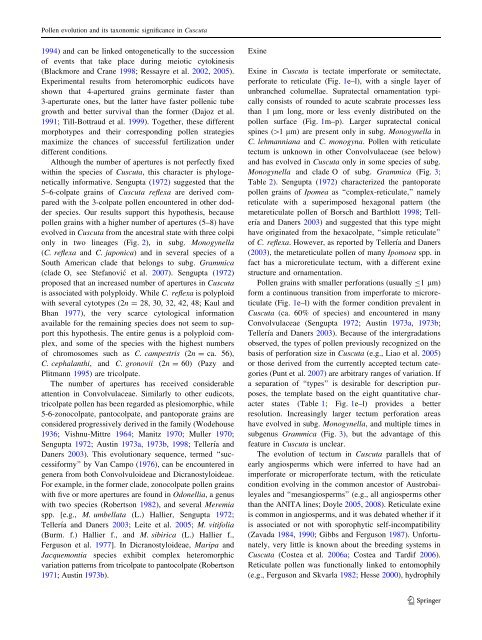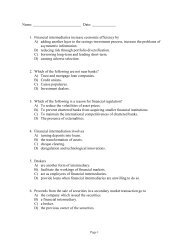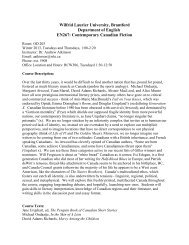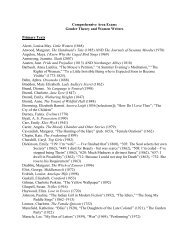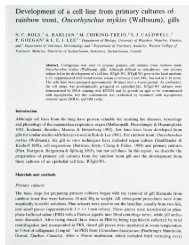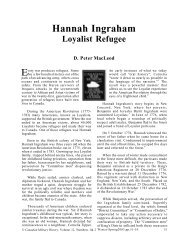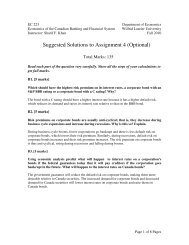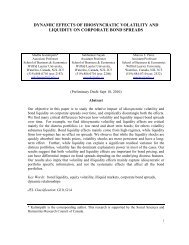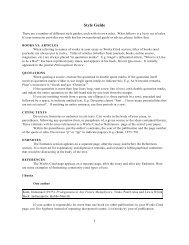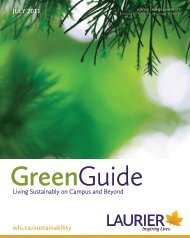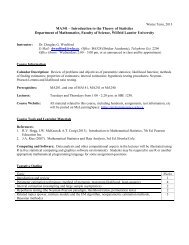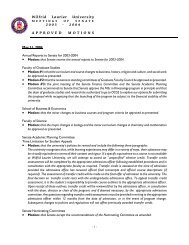Pollen evolution and its taxonomic significance in Cuscuta (dodders ...
Pollen evolution and its taxonomic significance in Cuscuta (dodders ...
Pollen evolution and its taxonomic significance in Cuscuta (dodders ...
You also want an ePaper? Increase the reach of your titles
YUMPU automatically turns print PDFs into web optimized ePapers that Google loves.
<strong>Pollen</strong> <strong>evolution</strong> <strong>and</strong> <strong>its</strong> <strong>taxonomic</strong> <strong>significance</strong> <strong>in</strong> <strong>Cuscuta</strong><br />
1994) <strong>and</strong> can be l<strong>in</strong>ked ontogenetically to the succession<br />
of events that take place dur<strong>in</strong>g meiotic cytok<strong>in</strong>esis<br />
(Blackmore <strong>and</strong> Crane 1998; Ressayre et al. 2002, 2005).<br />
Experimental results from heteromorphic eudicots have<br />
shown that 4-apertured gra<strong>in</strong>s germ<strong>in</strong>ate faster than<br />
3-aperturate ones, but the latter have faster pollenic tube<br />
growth <strong>and</strong> better survival than the former (Dajoz et al.<br />
1991; Till-Bottraud et al. 1999). Together, these different<br />
morphotypes <strong>and</strong> their correspond<strong>in</strong>g pollen strategies<br />
maximize the chances of successful fertilization under<br />
different conditions.<br />
Although the number of apertures is not perfectly fixed<br />
with<strong>in</strong> the species of <strong>Cuscuta</strong>, this character is phylogenetically<br />
<strong>in</strong>formative. Sengupta (1972) suggested that the<br />
5–6-colpate gra<strong>in</strong>s of <strong>Cuscuta</strong> reflexa are derived compared<br />
with the 3-colpate pollen encountered <strong>in</strong> other dodder<br />
species. Our results support this hypothesis, because<br />
pollen gra<strong>in</strong>s with a higher number of apertures (5–8) have<br />
evolved <strong>in</strong> <strong>Cuscuta</strong> from the ancestral state with three colpi<br />
only <strong>in</strong> two l<strong>in</strong>eages (Fig. 2), <strong>in</strong> subg. Monogynella<br />
(C. reflexa <strong>and</strong> C. japonica) <strong>and</strong> <strong>in</strong> several species of a<br />
South American clade that belongs to subg. Grammica<br />
(clade O, see Stefanović et al. 2007). Sengupta (1972)<br />
proposed that an <strong>in</strong>creased number of apertures <strong>in</strong> <strong>Cuscuta</strong><br />
is associated with polyploidy. While C. reflexa is polyploid<br />
with several cytotypes (2n = 28, 30, 32, 42, 48; Kaul <strong>and</strong><br />
Bhan 1977), the very scarce cytological <strong>in</strong>formation<br />
available for the rema<strong>in</strong><strong>in</strong>g species does not seem to support<br />
this hypothesis. The entire genus is a polyploid complex,<br />
<strong>and</strong> some of the species with the highest numbers<br />
of chromosomes such as C. campestris (2n = ca. 56),<br />
C. cephalanthi, <strong>and</strong> C. gronovii (2n = 60) (Pazy <strong>and</strong><br />
Plitmann 1995) are tricolpate.<br />
The number of apertures has received considerable<br />
attention <strong>in</strong> Convolvulaceae. Similarly to other eudicots,<br />
tricolpate pollen has been regarded as plesiomorphic, while<br />
5-6-zonocolpate, pantocolpate, <strong>and</strong> pantoporate gra<strong>in</strong>s are<br />
considered progressively derived <strong>in</strong> the family (Wodehouse<br />
1936; Vishnu-Mittre 1964; Manitz 1970; Muller 1970;<br />
Sengupta 1972; Aust<strong>in</strong> 1973a, 1973b, 1998; Tellería <strong>and</strong><br />
Daners 2003). This <strong>evolution</strong>ary sequence, termed ‘‘successiformy’’<br />
by Van Campo (1976), can be encountered <strong>in</strong><br />
genera from both Convolvuloideae <strong>and</strong> Dicranostyloideae.<br />
For example, <strong>in</strong> the former clade, zonocolpate pollen gra<strong>in</strong>s<br />
with five or more apertures are found <strong>in</strong> Odonellia, a genus<br />
with two species (Robertson 1982), <strong>and</strong> several Meremia<br />
spp. [e.g., M. umbellata (L.) Hallier, Sengupta 1972;<br />
Tellería <strong>and</strong> Daners 2003; Leite et al. 2005; M. vitifolia<br />
(Burm. f.) Hallier f., <strong>and</strong> M. sibirica (L.) Hallier f.,<br />
Ferguson et al. 1977]. In Dicranostyloideae, Maripa <strong>and</strong><br />
Jacquemontia species exhibit complex heteromorphic<br />
variation patterns from tricolpate to pantocolpate (Robertson<br />
1971; Aust<strong>in</strong> 1973b).<br />
Ex<strong>in</strong>e<br />
Ex<strong>in</strong>e <strong>in</strong> <strong>Cuscuta</strong> is tectate imperforate or semitectate,<br />
perforate to reticulate (Fig. 1e–l), with a s<strong>in</strong>gle layer of<br />
unbranched columellae. Supratectal ornamentation typically<br />
consists of rounded to acute scabrate processes less<br />
than 1 lm long, more or less evenly distributed on the<br />
pollen surface (Fig. 1m–p). Larger supratectal conical<br />
sp<strong>in</strong>es ([1 lm) are present only <strong>in</strong> subg. Monogynella <strong>in</strong><br />
C. lehmanniana <strong>and</strong> C. monogyna. <strong>Pollen</strong> with reticulate<br />
tectum is unknown <strong>in</strong> other Convolvulaceae (see below)<br />
<strong>and</strong> has evolved <strong>in</strong> <strong>Cuscuta</strong> only <strong>in</strong> some species of subg.<br />
Monogynella <strong>and</strong> clade O of subg. Grammica (Fig. 3;<br />
Table 2). Sengupta (1972) characterized the pantoporate<br />
pollen gra<strong>in</strong>s of Ipomea as ‘‘complex-reticulate,’’ namely<br />
reticulate with a superimposed hexagonal pattern (the<br />
metareticulate pollen of Borsch <strong>and</strong> Barthlott 1998; Tellería<br />
<strong>and</strong> Daners 2003) <strong>and</strong> suggested that this type might<br />
have orig<strong>in</strong>ated from the hexacolpate, ‘‘simple reticulate’’<br />
of C. reflexa. However, as reported by Tellería <strong>and</strong> Daners<br />
(2003), the metareticulate pollen of many Ipomoea spp. <strong>in</strong><br />
fact has a microreticulate tectum, with a different ex<strong>in</strong>e<br />
structure <strong>and</strong> ornamentation.<br />
<strong>Pollen</strong> gra<strong>in</strong>s with smaller perforations (usually B1 lm)<br />
form a cont<strong>in</strong>uous transition from imperforate to microreticulate<br />
(Fig. 1e–l) with the former condition prevalent <strong>in</strong><br />
<strong>Cuscuta</strong> (ca. 60% of species) <strong>and</strong> encountered <strong>in</strong> many<br />
Convolvulaceae (Sengupta 1972; Aust<strong>in</strong> 1973a, 1973b;<br />
Tellería <strong>and</strong> Daners 2003). Because of the <strong>in</strong>tergradations<br />
observed, the types of pollen previously recognized on the<br />
basis of perforation size <strong>in</strong> <strong>Cuscuta</strong> (e.g., Liao et al. 2005)<br />
or those derived from the currently accepted tectum categories<br />
(Punt et al. 2007) are arbitrary ranges of variation. If<br />
a separation of ‘‘types’’ is desirable for description purposes,<br />
the template based on the eight quantitative character<br />
states (Table 1; Fig. 1e–l) provides a better<br />
resolution. Increas<strong>in</strong>gly larger tectum perforation areas<br />
have evolved <strong>in</strong> subg. Monogynella, <strong>and</strong> multiple times <strong>in</strong><br />
subgenus Grammica (Fig. 3), but the advantage of this<br />
feature <strong>in</strong> <strong>Cuscuta</strong> is unclear.<br />
The <strong>evolution</strong> of tectum <strong>in</strong> <strong>Cuscuta</strong> parallels that of<br />
early angiosperms which were <strong>in</strong>ferred to have had an<br />
imperforate or microperforate tectum, with the reticulate<br />
condition evolv<strong>in</strong>g <strong>in</strong> the common ancestor of Austrobaileyales<br />
<strong>and</strong> ‘‘mesangiosperms’’ (e.g., all angiosperms other<br />
than the ANITA l<strong>in</strong>es; Doyle 2005, 2008). Reticulate ex<strong>in</strong>e<br />
is common <strong>in</strong> angiosperms, <strong>and</strong> it was debated whether if it<br />
is associated or not with sporophytic self-<strong>in</strong>compatibility<br />
(Zavada 1984, 1990; Gibbs <strong>and</strong> Ferguson 1987). Unfortunately,<br />
very little is known about the breed<strong>in</strong>g systems <strong>in</strong><br />
<strong>Cuscuta</strong> (Costea et al. 2006a; Costea <strong>and</strong> Tardif 2006).<br />
Reticulate pollen was functionally l<strong>in</strong>ked to entomophily<br />
(e.g., Ferguson <strong>and</strong> Skvarla 1982; Hesse 2000), hydrophily<br />
123


